Menus
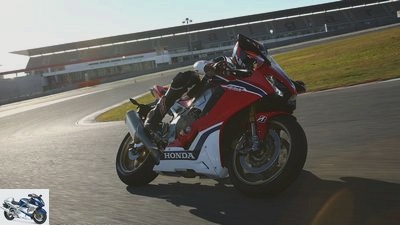
Honda

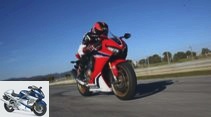
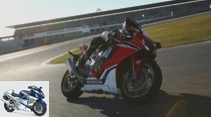
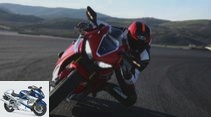
30th photos
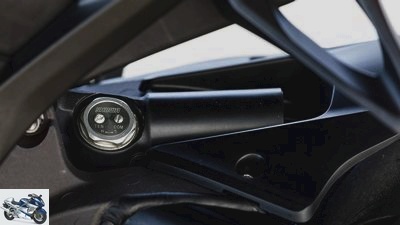
Honda
1/30
The adjusting screws of the rear Showa shock absorber are easily accessible.

Honda
2/30
The 2017 new Honda Fireblade has almost nothing in common with its predecessor.
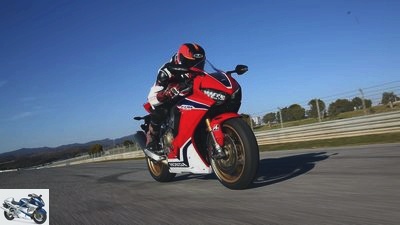
Honda
3/30
Open fire! 192 hp push the 195kg blade forward with a robust roar.
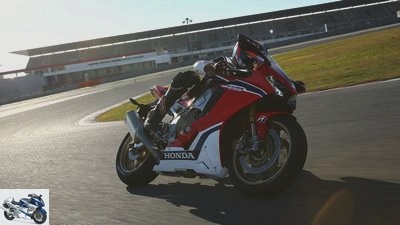
Honda
4/30
Braking behavior, cornering and braking can be determined from three different automatic modes. You can choose from Fast, Enjoy and Safety.
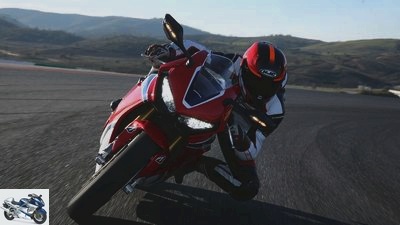
Honda
5/30
Changes to the setup and individual fine adjustments can be carried out in the twinkling of an eye and are immediately noticeable.
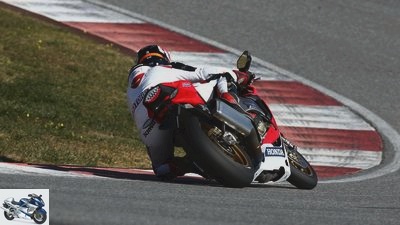
Honda
6/30
The weight reduction and mass centralization have clearly paid off.
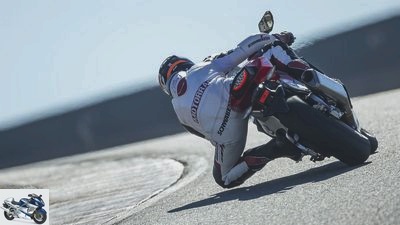
Honda
7/30
The Fireblade rages effortlessly through the curve passages.
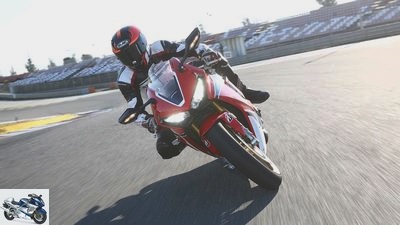
Honda
8/30
The more curved cooler allows a slightly narrower panel, which makes the blade look amazingly compact.
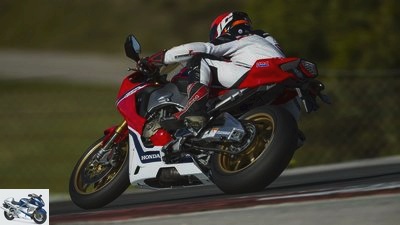
Honda
9/30
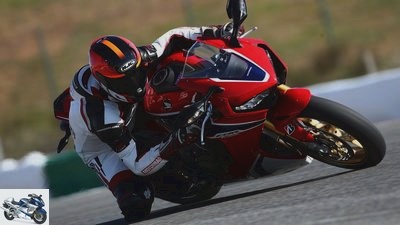
Honda
10/30
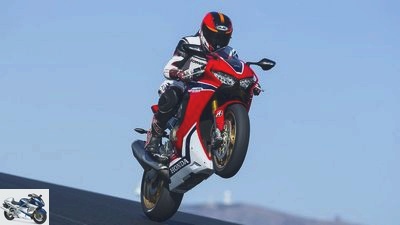
Honda
11/30
Even at the lowest level, the Wheelie Control allows powerful wheelies.
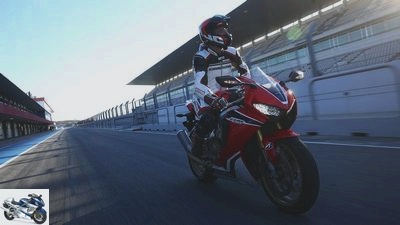
Honda
12/30
Despite all the helpers, maximum concentration is required. Then test driver Andi probably needs a short break.
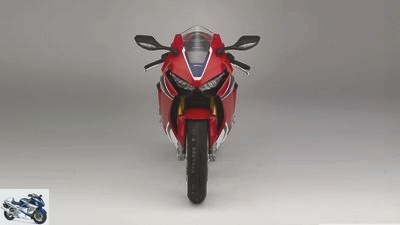
Honda
13/30
Easy to recognize: the SP variant stands out thanks to its HRC tricolor finish.
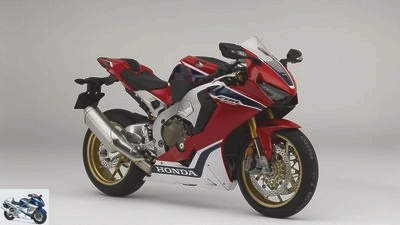
Honda
14/30
The SP boasts a titanium tank, Brembo brake system, semi-active Ohlins spring elements and an automatic gearshift.
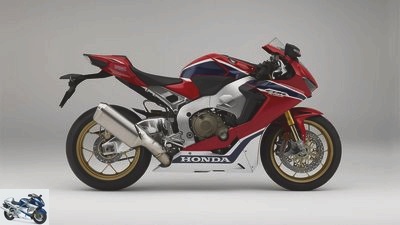
Honda
15/30
If you want to catch some wind protection, you have to make yourself small.
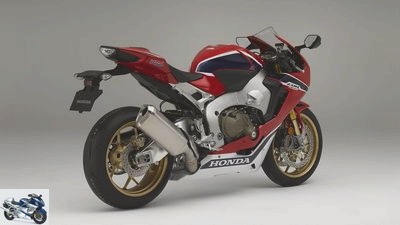
Honda
16/30
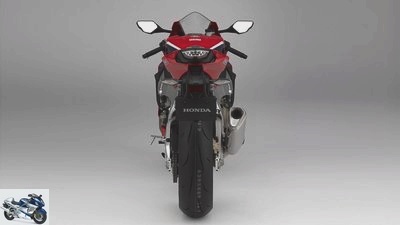
Honda
17/30
At the rear there is the Bridgestone S21 in the tried and tested 190/50 format as standard. According to Honda, weight reasons.
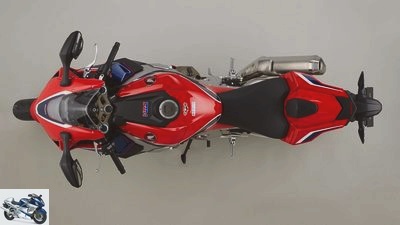
Honda
18/30
Thanks to the slightly more tapered frame, slim knee fastening.
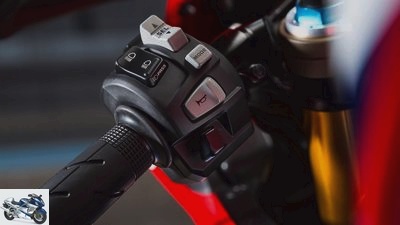
Honda
19/30
Menu navigation and operation of the electronics are clear.
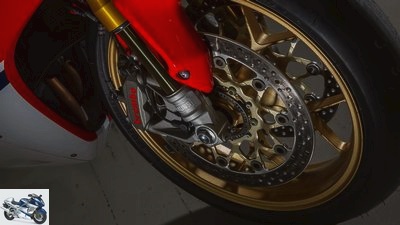
Honda
20/30
Although extremely filigree, the wheels are cast, not forged.
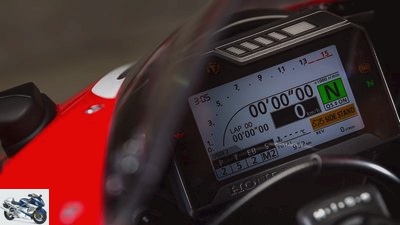
Honda
21/30
Clear, easy to read and with a wealth of information: TFT display
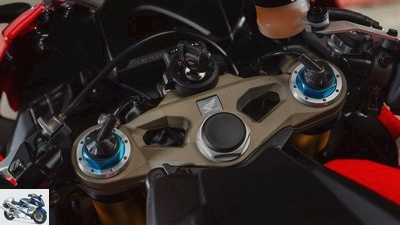
Honda
22/30
The parameters for the spring elements are recorded every ten milliseconds.
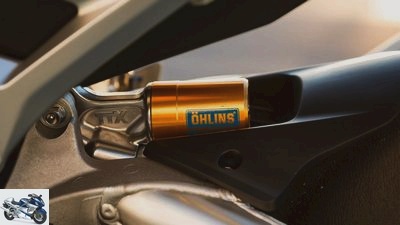
Honda
23/30
The TTX shock absorber has a hand wheel for the spring preload, tricolor paint only for the SP.

Honda
24/30
The automatic gearshift, which is standard on the SP, works perfectly in both directions.
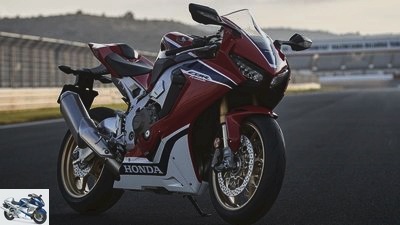
Honda
25/30
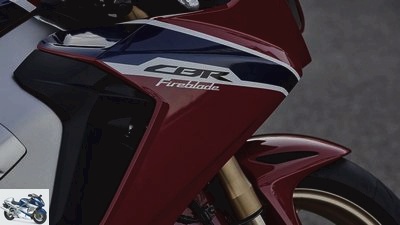
Honda
26/30
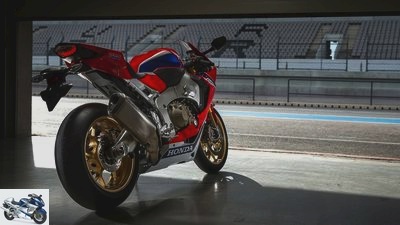
Honda
27/30
The best lap times are achieved with the SP on fine Bridgestone V02 slicks.
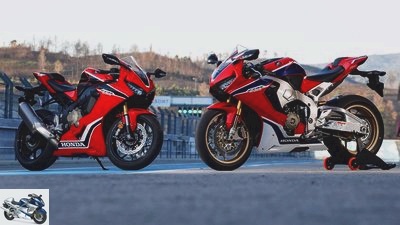
Honda
28/30
The only difference between the SP and the basic version is the brake caliper, spring element, tank and automatic switch.
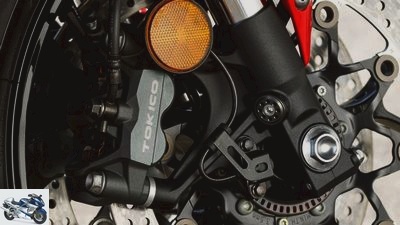
Honda
29/30
The Tokico pliers of the basic version offer an excellent hardware basis.
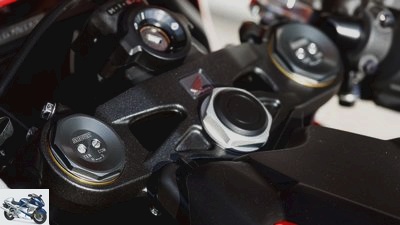
Honda
30/30
Big Piston Fork by Showa, control button of the electronics as with the SP on the left handlebar.
Honda Fireblade SP in the driving report
The seventh trick
Power up, weight down, plus lots of MotoGP electronics up to a semi-active chassis. The 7th generation of the Honda Fireblade is supposed to be at the forefront of superbikes again.
"Ninety percent of all components are new." Chief Engineer Kyoichi Yoshii’s eyes are literally full of excitement at the latest Honda Fireblade, internally named SC77. Basically only the basic chassis data remained the same. Hardly any component was left untouched. It was also high time. In the nine years of its construction, the predecessor SC59 had increased in weight, but hardly in performance. The competition was clearly ahead of her. Ride-by-Wire? Electronic driving aids? Except for the C-ABS, there was no news.
Buy complete article
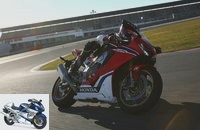
Honda Fireblade SP in the driving report
The seventh trick
Weight of the new Honda Fireblade
Gone, forget – a new era begins. 15 kilos less should make the Honda Firelade the lightest four-cylinder with 196 kilos in the base and 195 kilos in the SP version. That is less than the weight of the CBR 600 RR. So much in advance: We weighed it in the pit lane on a scale set up by Honda. You don’t seem to have exaggerated. In addition, thanks to the 2 millimeter larger throttle valves, new camshafts and pistons, there was a power boost of 11 hp.
Subscribe to MOTORRAD videos on Youtube
Driving aids and equipment
And the arsenal of electronic driving aids is now almost perfectly ammunitioned: Bosch IMU with five-axis gyro sensors, electronically controlled throttle valves, nine-stage wheelie and traction control, ABS (cannot be switched off) with cornering function and rear wheel lift detection, adjustable engine brake – everything on board. The only thing missing is a launch control. The Honda Fireblade SP even comes with an automatic gearshift with blipper function (optional for the basic version) as standard.
But let’s postpone the dry list of changes and innovations until later. Let’s jump straight onto the Portimão track with the Honda Fireblade SP. After the morning turns with the basic version and series tires, the SP version with tires with fine Bridgestone V02 slicks is now ready. SP, that means 1.7 kilograms lighter titanium tank, lighter lithium-ion battery, Brembo brake calipers and above all, of course, semi-active Ohlins spring elements.
From now on, they have to rethink. You have three different automatic modes ready: Fast, Enjoy and Safety. Each mode is divided into the driving situations braking, cornering and acceleration, which can be fine-tuned individually. The driving dynamics data for this is provided by the five-axis sensors every ten milliseconds. Sounds complicated, but thanks to the clear menu navigation on the brilliant TFT display adopted from the RC213V, it is not. And don’t worry, if you prefer to adjust your suspension with just a few clicks, the suspension elements of the new Honda Fireblade also offer three manually adjustable setup options.
Driving impression
So, now get into the saddle. The new Honda Fireblade looks amazingly compact, not like a 1000, more like a slightly larger 600. Thanks to the slightly more tapered frame, slim knee closure, the more curved radiator allows a slightly narrower panel, the whole front section looks delicate. You don’t have to spend a long time focusing on the Honda Fireblade, you immediately feel at home. The handling is excellent. Aim for the line, zigzag, into the curve – it almost works by itself. The 1000 meanders through alternating curves with casual suppleness and can be circled with a light hand through the fast arcs, nasty compressions and over blind knolls. Class! The feedback and neutrality down to the deepest slopes are also flawless.
The efforts to reduce weight and centralize masses have clearly paid off. Romping through bends with the Honda Fireblade is characterized by effortlessness. The frame shed 500 grams due to its thinner walls, the cladding parts are made of only 1.6 mm thick plastic. The new cast wheels are incredibly delicate. The engine alone lost two kilograms thanks to a redesigned cover, some of which (ignition) was cast from magnesium. The new rear frame saves another 800 grams. Hand was even put to work on radiator hoses, clamps and screw lengths. And the lightweight titanium exhaust further improves mass centralization. All of this leads to an enchanting maneuverability.
So, for the first time we plunge the endlessly long right-hand bend down the mountain to the start and finish – open fire! After a quick breath in mid-speed, the four-cylinder really tenses the muscles at 7,500 rpm and turns up with a hearty roar. The front wheel of the Honda Fireblade rises on a small hilltop, even in fifth gear. Here, as on the second crest in the back part of the route, it is evident that the Wheelie Control allows quite powerful wheelies at the lowest level, but then brings the front wheel back to the ground, but reduces the power almost too long before it is full power again allows. In the five-digit speed range, one or the other competitor may swing an even thicker club.
Compared to its predecessor, the new Honda Fireblade has noticeably gained muscle. Where previously the vigor slowly decreased from 11,000 rpm, the Honda Fireblade now pulls strongly towards the red area. However, if you want to catch some wind protection on the long straight, you have to make yourself small. In the slightly sloping braking zone, the electronics keep the rear wheel clean on the ground. However, the brake was not completely convincing, despite the noble components. The pressure point lacked consistency and crispness. Step down three gears without a clutch, the automatic gearshift works splendidly when shifting up and down. It can be adjusted to three levels in terms of leverage. It goes through the first right-hand arc with good taste. The spring elements iron smoothly over the bump. Likewise over the hard edge, which lurks in a violent depression and is taken with powerful speed and incline.
Adjust setup
However, on the brakes, the new Honda Fireblade tends slightly towards the outer edge of the curve. In addition, the rear should remain a bit calmer when accelerating out. So quickly turned into the pit lane. In short, the setting for braking using the menu button on the left handlebars is a little more soft, while for acceleration it is two steps tighter and back on the track. The changes to the setup are immediately noticeable. The Honda willingly follows the closer line, holding the rear quieter when accelerating. Tackled hard, the handlebars twitch when jiggled, but the electronic steering damper does its job excellently as always. We repeated the game with setup adjustments two or three more times, and the changes can always be traced directly on the track.
The new approach seems to be working. At 22,590 euros, the Honda Fireblade SP is just under 1,000 euros below the Yamaha YZF-R1M. No question about it, the light Honda Fireblade has gained in clout as an overall package without showing off maximum power. She stayed true to herself and her forefather.
Related articles
-
Honda CBR 1000 RR Fireblade SP in the test
Honda 22 pictures Honda 1/22 From the outside, there is hardly anything to suggest that Honda’s top athletes for 2014 will experience more than just visual retouching …
-
Honda Fireblade SP in the PS driving report
Honda 26 pictures Honda 1/26 Honda CBR 1000 RR Fireblade SP. Honda 2/26 New titanium rear silencer. Sounds wonderful, fits nicely into the line of …
-
Buenos Dias driving report Honda (2009) Now with ABS: CBR 600 RR Honda’s new sport ABS should decelerate perfectly, with Fireblade and CBR 600 RR. Works…
-
Technology 20 years of progress in motorcycle construction: Honda Fireblade – old against new
fact 14 pictures fact 1/14 At the end of 1991 Honda presented the first Fireblade and shook the athlete Olympus permanently. We compare the Fireblade …
-
Honda CBR 1000 RR Fireblade 2012
Honda 16 pictures Youtube 1/16 Honda CBR 1000 RR Fireblade 2012 Youtube 2/16 Honda CBR 1000 RR Fireblade 2012 Youtube 3/16 Honda CBR 1000 RR Fireblade 2012 …
-
Driving report: Honda CB 1100, Triumph Bonneville SE
Gargolov Driving report: two enthusiast models Honda CB 1100, Triumph Bonneville SE Fans of top speed, horsepower hype or maximum lean angle can now turn…
-
Driving report MotoGP-Honda RC 211 V
Rudolph driving report MotoGP-Honda RC 211 V (2005) Driving force beaten by Yamaha in the MotoGP class ?? the Honda racing department is in the …
-
Honda RC213V-S in the driving report
Honda 19 pictures Honda 1/19 The number of units of the Honda RC213V-S is small, but the price is high. You have to bring 200,000 euros. For this you get …
-
Kawasaki Versys 1000 SE driving report
Innovations 2019 Top Topic Kawasaki 22 pictures Kawasaki 1/22 colleague Jens Moller Toller aka MoTo drove the new Kawasaki Versys 1000 SE. In…
-
Kawasaki Versys 1000 driving report
Wright driving report: Kawasaki Versys 1000 (with video) Kawasaki’s all-rounder now with a large four-cylinder No half measures: For the Versys there is now the …